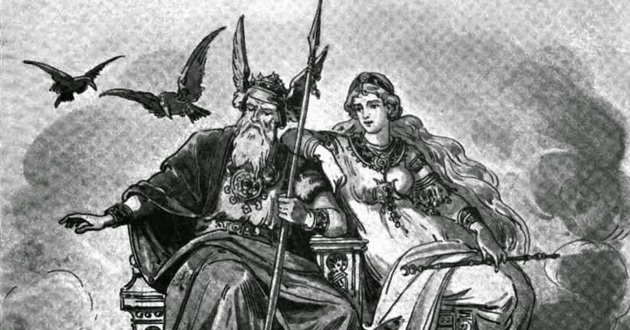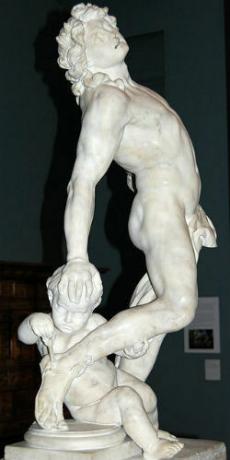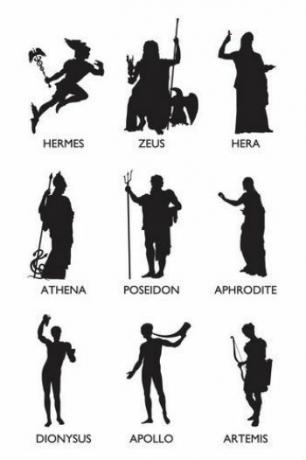THE Norse or Germanic mythology was developed in Scandinavian or Nordic countries, such as the current Sweden, Norway, Finland, Iceland and Denmark.
Like Greek, Roman and Egyptian mythology, Norse mythology has great importance in shaping the culture of the ancestors of these peoples. Until today, it inspires movies, comics, videos, games, etc.
Made up of gods, heroes, dwarves, giants, serpents, wolves and sorcerers, the legends relate events that seek to explain the origin of humanity, life after death, natural phenomena, among others.
Because it is a belief among various peoples, it is also called Viking or Germanic mythology.
The 9 Worlds of Norse Mythology
Norse mythology is composed of 9 worlds:

- Midgard: middle earth and realm of humans, which corresponds to planet Earth (physical world). Jord is the guardian goddess of this world.
- Asgard: separated from the human world by immense walls, Asgard is the realm of the gods (upper world, the heavens) and its guardian is Heimdall. Its leaders are Odin, the greatest god of Norse mythology, and Frigga, the goddess of fertility.
- Niflheim: ruled by the goddess Hel, goddess of hell, and daughter of Loki, Niflheim corresponds to the realm of ice and cold, where giants and ice dwarves meet.
- vanaheim: Resting world of the Vanir gods, birthplace of Njord, protector god of navigators, and head of the Vanir clan.
- Svartalfheim: place where the subterranean gods, called svartálfar, lived. Its leader is Hoder, blind god, brother of Balder, god of justice, and son of Odin and Frigga.
- Jotunheim: kingdom of giants, called Jotuns, and its main city is Utgard. Their leader is Thrym, king of giants.
- Nidavellir: dwarf realm, which is located in the underground of Midgard. Its leader is Vidar, god of revenge, and son of Odin.
- Muspelheim: fire kingdom, where the fire giants live. Their leader is Surtr, the fire giant.
- Alfheim: kingdom of elves, magical beings of human appearance and enormous beauty.
Bifrost
Bifrost is the name given to the bridge connecting the realm of gods, Asgard, and the realm of men, Midgard.
Yggdrasil
Mythical and sacred tree of Norse mythology, considered the tree of life and which supports the nine worlds. She is the hub of the world and her deep roots connect them.
Valhalla
Valhalla, called the “Hall of the Dead”, corresponds to the residence of the gods, that is, the place where they were received after honored death in battle.
Ragnarok
In Norse mythology, Ragnarök corresponds to the final destination of the gods. The battle of Ragnarök took place in the Midgard region, between the forces of good and evil, resulting in the end of the world and all creatures - gods, heroes, giants, monsters.
Note that, unlike other mythologies, in Norse mythology, the gods are not eternal, and with the battle of Ragnarök many of them will die, giving rise to new ones.

gods of nordic mythology
See below the main gods that make up Norse mythology:
- Odin: greatest of the Viking gods, the father of the gods.
- Freyr: god of abundance and brother to Freyja.
- Frigg: goddess of fertility and woman of Odin.
- Tyr: god of combat and son of Odin and Frigg.
- to live: god of revenge, son of Odin.
- Thor: god of thunder and son of Odin.
- bragi: messenger god of poetry and wisdom, son of Odin.
- bucket: god of justice and son of Odin and Frigga.
- Njord: protector god of browsers.
- freya: mother goddess of love and lust, and daughter of Njord and Skadi.
- Loki: half giant and half god, he is considered the father of lies.
- Hel: goddess of hell and daughter of Loki.
Odin
Odin he is the greatest of the Norse gods, the father of the gods. Odin is represented as an old man, but strong, and dressed in his warrior weapons, as he is the god of wisdom, war and death. He is also known as Wotan in Germanic mythology.
To gain wisdom, Odin offered one of his eyes to mimir, the guardian, and he was still nine days wounded by an arrow and hanging from the tree Yggdrasil, to be initiated into the runes. On the battlefields, Odin used to ride on his eight-legged horse, sleipnir.
Odin was married to Frigg and he had several children, including Thor and Vidar. His daughters are also the Valkyries, whom Odin sends to the battlefield in order to collect the bodies of those who died fighting bravely.
The warriors chosen by the Valkyries will live happily in the palace of Valhalla until the day of the Battle of Ragnarök, when Odin will be killed. It will not, however, be the end. The land will resurface fertile and will be repopulated by two human beings and an era of happiness will be ushered in.
Frigg
Frigga is the fertility goddess and wife of Odin. Frigg she is represented as a mother, warrior, and sage who knows men's secrets but does not reveal them. Symbols of it are the distaff, spindle and keys, which signify life span and wisdom.

When warriors die in combat, the Valkyries choose those who will go to Valhalla, along with Odin, and the other half will remain in Folkvang, close to the goddess.
There, they will spend the rest of their days exercising and participating in joyous feasts, until the end of time, at the Battle of Ragnarök.
Thor
Thor he is the god of thunder and son of Odin. Perhaps the most popular Norse god to date, as his cult was taken to England by the Vikings. The Romans also met him when they were fighting the Germans and ended up describing him in their accounts.
Thor is the son of Odin and Jord, the personification of Earth, and is a warrior who uses the magic hammer, Mjolnir, which never misses the target, and can be reduced in size.
The ancients believed that the thunders were proof that Thor was using the hammer, hence the belief in considering him as a god of Thunder.
Thor was married twice and fathered four children. The second marriage, the most important, was with Sfi, who bore him three children.
Sfi was a beautiful goddess and also a skilled warrior. At the end of time, during the Battle of Ragnarök, it is said that Thor will kill and be killed by Jörmundgander, the great serpent.
Nordic Creatures
In addition to the gods (higher entities), several creatures are part of Norse mythology, namely:
- heroes: possessed some powers and performed great deeds.
- Dwarves: beings that possessed high superior intelligence.
- jotuns: giants who had special powers.
- monsters: also called beasts, possessed supernatural powers.
- Valkyries: are the servants of the greatest of the gods: Odin.
- elves: beautiful immortal creatures, with magical powers and that resemble humans. They are inhabitants of forests, springs and woods.
read more:
- Vikings
- Egyptian Mythology
- Roman mythology
- Greek gods
- Myths and legends from Brazil and the world



